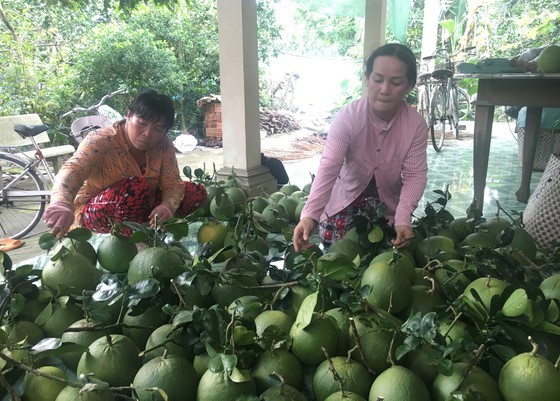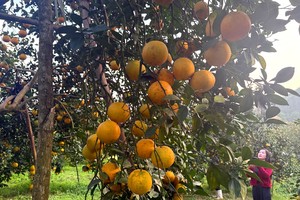 Farmers in Ben Tre Province harvest pomelos. (Photo: SGGP)
Farmers in Ben Tre Province harvest pomelos. (Photo: SGGP)
Quality depends on the preservation
Currently, the Mekong Delta contributes about 90 percent of rice production, 65 percent of aquatic product production, and 70 percent of fruit production for national export. Besides the underdeveloped transport infrastructure, the Mekong Delta also lacks key logistics centers, satellite systems, food safety inspection units, and qualified irradiation facilities. Moreover, the Mekong Delta has only three logistics centers that are not enough to serve the whole region.
Ms. Ngo Tuong Vy, Deputy Director of Chanh Thu Fruits Import and Export Co., Ltd., cited that currently, logistics costs for Vietnamese dragon fruits to the US and the EU account for more than 30 percent of production cost. If dragon fruits are transported by air, the cost is 15 times higher than that by sea. Meanwhile, Thailand’s logistics costs for dragon fruits only account for 15 percent of the production cost.
For example, An Giang Province grows high-quality mangoes and has relatively complete infrastructure. However, the company has to transport mangoes from An Giang to Ben Tre Province for preliminary processing and preservation. Normally, after cutting from the trees, fruits should be stored in cold storage immediately. If they are left outside, the longevity of fruits will decrease; on average, for every hour outside, the longevity of fruits will be reduced by one day.
Therefore, Vietnam cannot compete with other countries in the region. If there are many logistics centers and infrastructure is completed, it will increase the competitiveness of Vietnamese fruits, and farmers will benefit from the reduction in transportation costs.
According to Mr. Tran Van Quoc, Chairman of the Board of Directors of Thuan Hoa Soursop Cooperative in Hau Giang Province, soursop products of farmers meet the standards but can only be consumed locally, instead of being transported to the raw material areas for sale. Mostly, farmers can only sell their products to a few traders, leading to a price squeeze.
Specializing in exporting frozen fruits, Ms. Le Thi Thu Truc, Deputy CEO of Phu Thinh Food Export Company, shared that building infrastructure and logistics center is a long-time problem of agricultural enterprises in the Mekong Delta that has not had any solution yet. When fruits are in season, the company has to do its best to buy products from farmers and cooperatives to stockpile for the whole year. Although it has warehouses to store fruits, it is unable to buy all of the farmers' output. If building more warehouses, the company will have to spend very high costs for premises, construction, and operation, but it can only use its warehouses seasonally, which is not economically efficient.
Currently, the process is that farmers harvest their fruits then sell them to small traders, small traders sell to large traders, large traders sell to manufacturers, and manufacturers continue to sell to processors or exporters. Just like that, through each stage, there are intermediate fees for traders and transportation, thereby increasing cost prices.
Each production area needs a logistics center
According to Mr. Dang Phuc Nguyen, General Secretary of the Vietnam Fruit and Vegetable Association, agricultural products in the Mekong Delta are constrained by many factors, including the burden of logistics costs, reducing their competitiveness compared to agriculture products of other countries, such as Thailand and China. Logistics is an important service industry, playing a supporting role, thereby creating sustainable consumption for farmers. Therefore, focusing on regional linkage and creating conditions for trade are urgent matters. Especially, it is necessary to have an effective processing and production model soon. To achieve this expectation, it is necessary to have teamwork between the State and enterprises.
To reduce transportation costs, increase competitiveness with other countries in the region, Mr. Pham Tien Hoai, CEO of Hanh Nguyen Logistics Center, analyzed that a logistics center comprises cold storage, preliminary processing area, and processing factory so that agricultural products do not have to pass through many traders and transportation stages. The logistics center gathers manufacturers, processors, and exporters. This helps farmers avoid the pressure of time to close the deal, freely find consumers for their products, and receive profits that commensurate with their efforts and investment, and the situation of rescuing agricultural products will no longer happen.
With a strict preservation process, agricultural products can be preserved for up to 90 days instead of just seven days as currently. The center also opened hundreds of showrooms for enterprises to trade with international importers. This means that international importers do not need to travel around the Mekong Delta region to look for agricultural products for importing as before, but they only need to visit the above center to choose the most satisfying products.
Although the State has had orientation, policy, and planning, farmers and cooperatives still operate separately, Professor-Dr. Vo Tong Xuan, Rector of Nam Saigon Polytechnic College, said. Firstly, each growing area needs a logistics center to preserve and preliminarily process on the spot to avoid the situation of overloading when agricultural products are in the season. After being harvested, agricultural products will be preserved immediately. Currently, there is no specific planning, so each locality produces products spontaneously and separately.
To be successful, localities need to have policies for investors, such as capita and land. If logistics centers are linked together, it will create a large-scale concentrated production area, with high technology and consumption in the value chain of agricultural products, suitable for the global market. As for localities, it is necessary to improve infrastructure and industrial zones towards modernity that link with arterial roads and effectively exploit ports for convenient circulation and transportation of goods.
Currently, the Mekong Delta contributes about 90 percent of rice production, 65 percent of aquatic product production, and 70 percent of fruit production for national export. Besides the underdeveloped transport infrastructure, the Mekong Delta also lacks key logistics centers, satellite systems, food safety inspection units, and qualified irradiation facilities. Moreover, the Mekong Delta has only three logistics centers that are not enough to serve the whole region.
Ms. Ngo Tuong Vy, Deputy Director of Chanh Thu Fruits Import and Export Co., Ltd., cited that currently, logistics costs for Vietnamese dragon fruits to the US and the EU account for more than 30 percent of production cost. If dragon fruits are transported by air, the cost is 15 times higher than that by sea. Meanwhile, Thailand’s logistics costs for dragon fruits only account for 15 percent of the production cost.
For example, An Giang Province grows high-quality mangoes and has relatively complete infrastructure. However, the company has to transport mangoes from An Giang to Ben Tre Province for preliminary processing and preservation. Normally, after cutting from the trees, fruits should be stored in cold storage immediately. If they are left outside, the longevity of fruits will decrease; on average, for every hour outside, the longevity of fruits will be reduced by one day.
Therefore, Vietnam cannot compete with other countries in the region. If there are many logistics centers and infrastructure is completed, it will increase the competitiveness of Vietnamese fruits, and farmers will benefit from the reduction in transportation costs.
According to Mr. Tran Van Quoc, Chairman of the Board of Directors of Thuan Hoa Soursop Cooperative in Hau Giang Province, soursop products of farmers meet the standards but can only be consumed locally, instead of being transported to the raw material areas for sale. Mostly, farmers can only sell their products to a few traders, leading to a price squeeze.
Specializing in exporting frozen fruits, Ms. Le Thi Thu Truc, Deputy CEO of Phu Thinh Food Export Company, shared that building infrastructure and logistics center is a long-time problem of agricultural enterprises in the Mekong Delta that has not had any solution yet. When fruits are in season, the company has to do its best to buy products from farmers and cooperatives to stockpile for the whole year. Although it has warehouses to store fruits, it is unable to buy all of the farmers' output. If building more warehouses, the company will have to spend very high costs for premises, construction, and operation, but it can only use its warehouses seasonally, which is not economically efficient.
Currently, the process is that farmers harvest their fruits then sell them to small traders, small traders sell to large traders, large traders sell to manufacturers, and manufacturers continue to sell to processors or exporters. Just like that, through each stage, there are intermediate fees for traders and transportation, thereby increasing cost prices.
Each production area needs a logistics center
According to Mr. Dang Phuc Nguyen, General Secretary of the Vietnam Fruit and Vegetable Association, agricultural products in the Mekong Delta are constrained by many factors, including the burden of logistics costs, reducing their competitiveness compared to agriculture products of other countries, such as Thailand and China. Logistics is an important service industry, playing a supporting role, thereby creating sustainable consumption for farmers. Therefore, focusing on regional linkage and creating conditions for trade are urgent matters. Especially, it is necessary to have an effective processing and production model soon. To achieve this expectation, it is necessary to have teamwork between the State and enterprises.
To reduce transportation costs, increase competitiveness with other countries in the region, Mr. Pham Tien Hoai, CEO of Hanh Nguyen Logistics Center, analyzed that a logistics center comprises cold storage, preliminary processing area, and processing factory so that agricultural products do not have to pass through many traders and transportation stages. The logistics center gathers manufacturers, processors, and exporters. This helps farmers avoid the pressure of time to close the deal, freely find consumers for their products, and receive profits that commensurate with their efforts and investment, and the situation of rescuing agricultural products will no longer happen.
With a strict preservation process, agricultural products can be preserved for up to 90 days instead of just seven days as currently. The center also opened hundreds of showrooms for enterprises to trade with international importers. This means that international importers do not need to travel around the Mekong Delta region to look for agricultural products for importing as before, but they only need to visit the above center to choose the most satisfying products.
Although the State has had orientation, policy, and planning, farmers and cooperatives still operate separately, Professor-Dr. Vo Tong Xuan, Rector of Nam Saigon Polytechnic College, said. Firstly, each growing area needs a logistics center to preserve and preliminarily process on the spot to avoid the situation of overloading when agricultural products are in the season. After being harvested, agricultural products will be preserved immediately. Currently, there is no specific planning, so each locality produces products spontaneously and separately.
To be successful, localities need to have policies for investors, such as capita and land. If logistics centers are linked together, it will create a large-scale concentrated production area, with high technology and consumption in the value chain of agricultural products, suitable for the global market. As for localities, it is necessary to improve infrastructure and industrial zones towards modernity that link with arterial roads and effectively exploit ports for convenient circulation and transportation of goods.
























